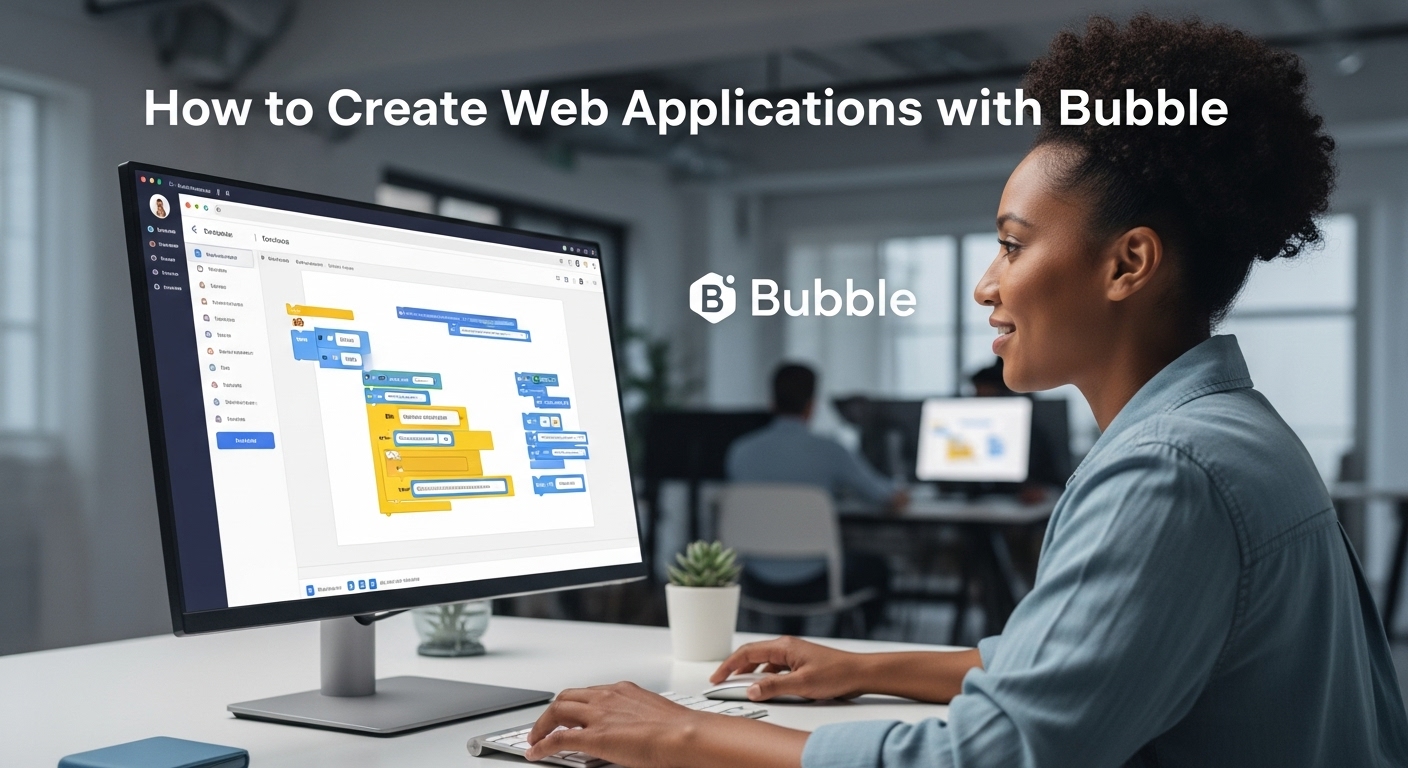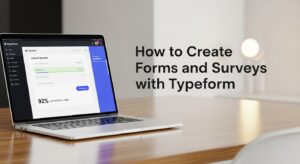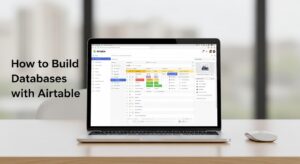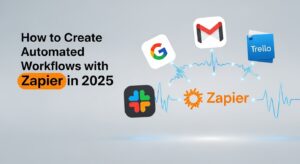In today’s digital landscape, the ability to create web applications with Bubble has revolutionized how entrepreneurs, businesses, and developers bring their ideas to life. Bubble is a powerful no-code platform that enables anyone to build fully functional web applications without writing a single line of code.
Whether you’re a startup founder with limited technical resources, a business owner looking to digitize operations, or a developer seeking to prototype quickly, learning how to create web applications with Bubble can save you thousands of dollars and months of development time.
This comprehensive guide will walk you through everything you need to know about building web applications using Bubble’s visual programming interface.
What is Bubble and Why Choose It for Web Application Development?
Bubble is a visual programming platform that allows users to create web applications with Bubble’s drag-and-drop interface. Founded in 2012, Bubble has powered over 3 million applications and continues to be a leading choice for no-code development.
Key Advantages of Using Bubble:
- No coding required: Build complex applications visually
- Full-stack capabilities: Handle both frontend and backend development
- Scalable infrastructure: Bubble handles hosting, security, and scaling
- Rich plugin ecosystem: Extend functionality with thousands of plugins
- Custom workflows: Create complex business logic without code
- Real-time collaboration: Work with teams seamlessly
According to Bubble’s official statistics, over 1.2 million users have chosen to create web applications with Bubble, making it one of the most trusted no-code platforms available.
Step 1: Setting Up Your Bubble Account and Workspace
To begin your journey to create web applications with Bubble, you’ll need to set up your development environment properly.
Getting Started:
- Sign up for a Bubble account at bubble.io
- Choose your plan: Start with the free tier for learning
- Create your first app: Select “New App” from your dashboard
- Configure basic settings: Set your app name, description, and primary language
Bubble Pricing Overview:
Plan | Price | Key Features |
Free | $0/month | Bubble branding, basic features |
Starter | $25/month | Remove branding, custom domain |
Growth | $115/month | More capacity, workflows |
Team | $349/month | Collaboration features, staging |
Step 2: Understanding Bubble’s Visual Development Environment
When you create web applications with Bubble, you’ll work primarily within four main tabs:
Design Tab
This is where you’ll build your user interface using Bubble’s visual elements:
- Elements: Text, buttons, inputs, images, and more
- Layout tools: Groups, repeating groups, and responsive settings
- Styling options: Colors, fonts, borders, and spacing
Workflow Tab
Create the logic that powers your application:
- Events: User actions that trigger workflows
- Actions: What happens when events occur
- Conditions: When workflows should or shouldn’t run
Data Tab
Design your application’s database structure:
- Data types: Define your database tables
- Fields: Add properties to your data types
- Privacy rules: Control who can access what data
Styles Tab
Maintain consistent design across your application:
- Style variables: Reusable design elements
- Color schemes: Consistent color palettes
- Typography: Font families and text styles
Step 3: Designing Your Web Application’s User Interface
The visual design phase is crucial when you create web applications with Bubble. A well-designed interface enhances user experience and ensures your application meets professional standards.
Essential Design Principles:
Responsive Design: Ensure your application works on all devices by:
- Setting up responsive breakpoints
- Using flexible layouts with groups
- Testing on different screen sizes
User Experience (UX) Best Practices:
- Keep navigation intuitive and consistent
- Use clear, actionable button text
- Maintain visual hierarchy with proper spacing
- Implement loading states for better feedback
Common UI Elements to Master:
- Headers and Navigation: Create consistent site-wide navigation
- Forms and Inputs: Design user-friendly data collection interfaces
- Data Display: Use repeating groups to show dynamic content
- Modals and Popups: Implement overlays for focused interactions
For inspiration and best practices, check out Bubble’s template marketplace, which showcases professionally designed applications.
Step 4: Building Database Structure and Data Management
A robust database structure is fundamental when you create web applications with Bubble. Bubble’s built-in database system handles all the complexity of data storage and retrieval.
Database Design Best Practices:
Data Types Planning:
- Identify all entities your app needs (Users, Products, Orders, etc.)
- Define relationships between data types
- Plan for scalability from the start
Field Configuration:
- Use appropriate field types (text, number, date, etc.)
- Set up required fields and default values
- Configure lists for one-to-many relationships
Security and Privacy Rules:
Bubble’s privacy rule system ensures data security:
Example Privacy Rule for User Data:
- Data type: User
- When: Current User is This User
- Read: yes
- Create: no (handled by signup)
- Modify: yes (own profile only)
Important: Always implement proper privacy rules before launching your application to protect sensitive user data.
Step 5: Creating Workflows and Business Logic
Workflows are the backbone of functionality when you create web applications with Bubble. They define how your application responds to user interactions and automates business processes.
Types of Workflows:
Page Workflows:
- Triggered by user interactions on specific pages
- Handle form submissions, button clicks, and page loads
- Control navigation between pages
Backend Workflows:
- Run on Bubble’s servers without user interaction
- Handle scheduled tasks, bulk operations, and API calls
- Process data safely away from the user interface
Custom Events:
- Reusable workflow components
- Reduce code duplication
- Improve maintainability
Workflow Best Practices:
Practice | Description | Benefits |
Use conditions | Add conditional logic to workflows | Prevents errors, improves UX |
Error handling | Include “Only when” conditions | Graceful failure management |
Step organization | Group related actions together | Easier debugging and maintenance |
Custom events | Create reusable workflow components | Reduced duplication, cleaner code |
Step 6: Integrating APIs and Third-Party Services
Modern web applications rarely operate in isolation. When you create web applications with Bubble, you’ll often need to integrate with external services and APIs.
Common Integration Categories:
Payment Processing:
- Stripe for credit card payments
- PayPal for alternative payment methods
- Bubble’s built-in Stripe plugin simplifies payment integration
Communication Services:
- SendGrid for email automation
- Twilio for SMS notifications
- Slack for team communications
Authentication Providers:
- Google OAuth for social login
- Facebook Login for social authentication
- Auth0 for enterprise authentication
API Integration Process:
- Install relevant plugins from Bubble’s marketplace
- Configure API keys in your app settings
- Set up API calls in your workflows
- Handle responses and error states properly
- Test thoroughly in development mode
The Bubble Plugin Store offers over 1,000 plugins to extend your application’s capabilities without custom coding.
Step 7: Testing, Debugging, and Deploying Your Web Application
The final phase of creating web applications with Bubble involves thorough testing and successful deployment.
Testing Strategies:
Functional Testing:
- Test all user workflows end-to-end
- Verify database operations work correctly
- Ensure integrations function as expected
Performance Testing:
- Monitor page load times
- Check database query efficiency
- Optimize heavy workflows
Security Testing:
- Verify privacy rules prevent unauthorized access
- Test input validation and sanitization
- Check for potential security vulnerabilities
Debugging Tools:
Bubble provides several debugging features:
- Step-by-step debugger: Watch workflows execute in real-time
- Issue checker: Identifies common problems automatically
- Server logs: Review backend workflow execution
- Performance monitor: Track app speed and optimization opportunities
Deployment Process:
- Review and fix all issues identified by Bubble’s issue checker
- Choose your deployment option:
- Deploy to live (bubble-generated subdomain)
- Deploy to custom domain (requires paid plan)
- Configure production settings:
- Set up SSL certificates
- Configure custom error pages
- Optimize performance settings
- Monitor your live application using Bubble’s analytics tools
Advanced Tips for Creating Professional Web Applications with Bubble
Performance Optimization:
- Optimize database searches: Use constraints and sorting efficiently
- Implement pagination: Load data in chunks for better performance
- Use caching: Store frequently accessed data temporarily
- Minimize workflow complexity: Break complex workflows into smaller parts
SEO and Marketing Optimization:
When you create web applications with Bubble, don’t forget about discoverability:
- Configure meta titles and descriptions for each page
- Implement proper URL structures
- Add social media sharing capabilities
- Set up analytics tracking (Google Analytics, Facebook Pixel)
Maintenance and Updates:
- Regular backups: Use Bubble’s backup features
- Version control: Create app versions before major changes
- Monitor performance: Track app metrics regularly
- User feedback: Implement feedback collection systems
Common Challenges and Solutions When Creating Web Applications with Bubble
- Challenge 1: Complex Logic Implementation
- Solution: Break complex processes into smaller, manageable custom events and backend workflows.
- Challenge 2: Performance Issues
- Solution: Optimize database queries, implement pagination, and use Bubble’s performance profiling tools.
- Challenge 3: Scaling Concerns
- Solution: Design for scalability from the start, use efficient data structures, and consider upgrading to higher-tier plans.
- Challenge 4: Integration Difficulties
- Solution: Thoroughly read plugin documentation, test integrations in development, and reach out to the Bubble community for support.
Resources for Continued Learning
To master how to create web applications with Bubble, leverage these valuable resources:
- Bubble Academy: Official learning platform with structured courses
- Bubble Forum: Active community for questions and discussions
- YouTube Tutorials: Free video content from Bubble and community creators
- Bubble Blog: Latest updates, tips, and case studies
- Documentation: Comprehensive reference for all Bubble features
Conclusion: Your Journey to Create Web Applications with Bubble
Learning to create web applications with Bubble opens up unlimited possibilities for bringing your digital ideas to life. From simple landing pages to complex marketplaces, Bubble’s visual development platform empowers anyone to build professional web applications without traditional coding barriers.
The key to success lies in understanding Bubble’s core concepts: visual design, database structure, workflow logic, and proper testing practices. By following this comprehensive guide and practicing regularly, you’ll be able to create web applications with Bubble that rival those built by traditional development teams.
Mastering any new skill takes time and practice. Start with simple projects to build confidence, gradually tackling more complex applications as your expertise grows. The Bubble community is incredibly supportive, so don’t hesitate to ask questions and share your progress.
Whether you’re building your first startup, creating internal business tools, or exploring new career opportunities in no-code development, the ability to create web applications with Bubble is an invaluable skill in today’s digital economy.
Start your Bubble journey today, and transform your ideas into reality without writing a single line of code.











